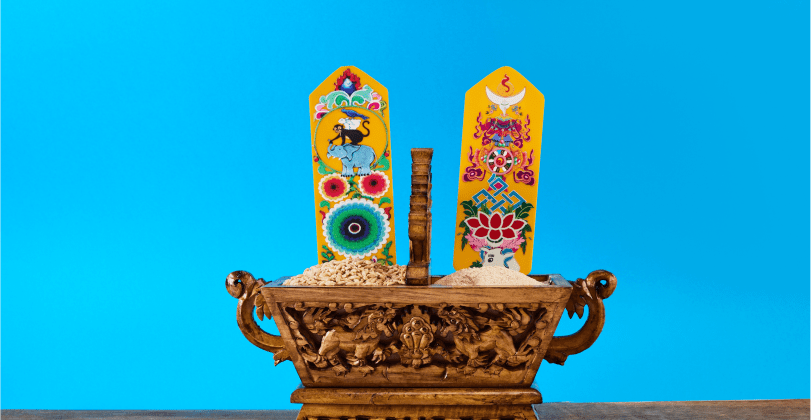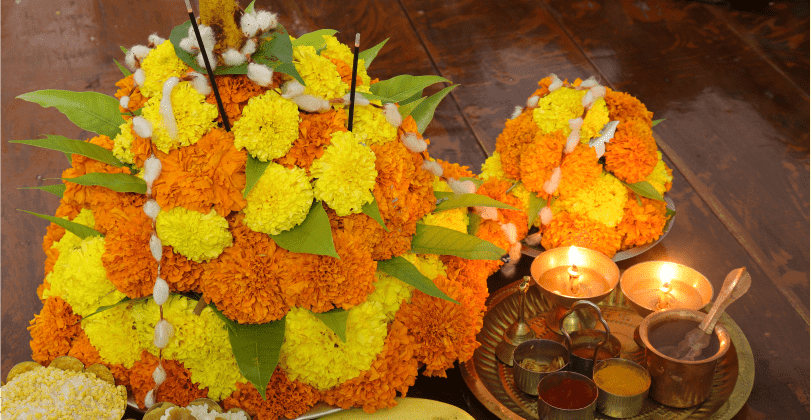Maharashtra Din, also known as Maharashtra Day, is an important celebration marking the formation of the state of Maharashtra. Maharashtra Day holds immense historical and
Losar, the Tibetan New Year, is a joyful and colourful festival celebrated by Tibetan communities. It marks the start of the lunisolar calendar year and symbolises new beginnings, cleansing, and the victory of good over evil.
The Losar festival lasts several days and includes vibrant rituals, feasts, music, and dance. People make offerings to deities, clean their homes to remove bad luck, and exchange blessings with loved ones. This special time brings families and communities together and showcases Tibetan culture and spiritual traditions.
This blog will explore the meaning and customs of the Losar festival, offering insights into its rich cultural significance and the joyous celebrations that define it.
What is the Losar Festival?
The literal meaning of Losar translates to 'Lo’-year and 'Sar'- New. This day marks the first day of the Tibetan lunar calendar. The Tibetan Losar festival is a major celebration lasting one to two weeks, filled with religious, cultural, and festive events. It's the best time to experience Tibetan culture and cuisine. People dress in traditional attire, and colourful prayer flags decorate homes, monasteries, and hills. The Tibetan New Year Festival in India is celebrated vibrantly and joyfully, showcasing the rich heritage and customs of the Tibetan community.
About Losar Festival - The History
The origins of Losar trace back to pre-Buddhist times, when the Tibetan people practiced the Bon religion. In winter, a spiritual ceremony was conducted where devotees burned incense to appease local deities and spirits, believing this would ensure the well-being of their community and environment. This ceremony evolved into a festival celebrated by farmers during the apricot blossom season.
During the reign of Tibet's 9th King, Pude Gungyal, an elderly woman taught the method of tracking time-based on the lunar phases. With the establishment of the lunar calendar, the farmers' festival transformed into what is now known as Losar.
Losar became the vibrant New Year celebration it is today, preserving historical and cultural heritage while marking the start of the lunar year.
How is the Tibetan New Year Celebrated?
The Tibetan festival of Losar is celebrated for different lengths of time based on local traditions, but the first three days are particularly important.
Weeks before the Losar festival, homes are meticulously cleaned to remove bad luck and welcome good fortune. Families decorate their homes with colourful prayer flags and prepare special foods and offerings. Traditional items like barley, dough, and fried cookies called khapse are prominently featured.
-
First Day: Lama-Losar
- The festival begins with Lama-Losar. On this day, people visit monasteries to pay their respects and receive blessings from the Lamas. This day is typically reserved for family gatherings.
- Rituals and prayers are performed at home, butter lamps are lit, and incense is burned to purify the space and invite positive energies.
- Ancestral shrines are given special attention, cleaned, and adorned with offerings.
- Many families also burn pine resin and put coloured grains and wheat on their roofs before daybreak to wish for a prosperous new year.
-
Second Day: Gyalpo-Losar
- On the second day, Gyalpo-Losar focuses on secular activities and public celebrations. "Gyalpo" means king, representing authority and governance.
- This day features grand public festivities, including traditional music, dance performances, and cultural shows. Community gatherings and feasts are common, with people donning their best traditional attire.
- Government officials and community leaders often participate in the celebrations, highlighting the festival's communal and civic aspects.
-
Third Day: Choe-Kyong-Losar
- The third day, Chokyong-Losar, is dedicated to honouring the guardian deities. "Choekyong" means protector deities, and on this day, prayer flags are hoisted on hills, rooftops, and around homes to invoke the blessings of these deities.
- Families engage in prayer rituals, read supplication prayers, and make offerings to ensure protection and prosperity for the coming year.
Throughout the festival, Tibetan communities in India come together, strengthening bonds and preserving their rich cultural heritage. Losar is a time of religious significance, as well as a celebration of community, family, and cultural identity.
Best Places to Witness Losar in India
Some states in India celebrate the Tibetan New Year ardently. Here are some places you can visit to witness the cultural beauty of this festival:
- Leh-Ladakh: Ladakh offers a remarkable setting for experiencing the Losar Festival. Streets are adorned with Happy Losar 2025 posters and Tibetan decorations outside homes. The Namgyal Monastery serves as a focal point for festivities, featuring captivating Cham dance performances.
- Bodh Gaya: Renowned as the site of Buddha's enlightenment, Bodh Gaya draws visitors worldwide during the festival for blessings and celebratory events.
- Sikkim: Sikkim is a favoured destination to witness the Tibetan Losar 2025 festival. At the Rumtek Monastery, festivities include the traditional Lama dance, while monks perform the Gutor Cham during Losar.
- Arunachal Pradesh: In Tawang, Arunachal Pradesh, Losar festivities span fifteen days, marked by home cleaning and warm welcomes extended to relatives and visitors.
- Himachal Pradesh: Various locales in Himachal Pradesh, including Mcleodganj, Spiti, Manali, and Shimla, host vibrant celebrations of the Losar festival.
When is The Losar Festival?
Losar falls on 28th February in 2025. As the celebrations span three days, the festival will end on 2nd March 2025. Losar is a public holiday in Tibet, Nepal, Bhutan, and Sikkim, India. It is also celebrated in Leh-Ladakh, Arunachal Pradesh, Darjeeling, and Himachal Pradesh, where it is observed as a restricted holiday.
| Occasion | Dates (2025) | States |
|---|---|---|
| Losar | 28th February - 2nd March | Arunachal Pradesh, Sikkim, Ladakh, Himachal Pradesh, Darjeeling |
| Occasion | Dates (2025) | States |
|---|---|---|
| Losar | 28th February - 2nd March | Arunachal Pradesh, Sikkim, Ladakh, Himachal Pradesh, Darjeeling |
Welcoming the Tibetan New Year
Losar, the Tibetan New Year, is a vibrant celebration deeply rooted in historical and cultural traditions. From its origins in the pre-Buddhist Bon religion to its transformation into a lunar-based festival, Losar reflects a rich tapestry of spiritual and communal practices. Across various regions in India and beyond, communities come together to honour their heritage with colourful decorations, traditional dances, and heartfelt rituals. Celebrating Losar not only marks the beginning of a new year but also preserves and celebrates the enduring cultural legacy of the Tibetan people.
Before You Go…
Do you want to witness the vibrancy of the Losar festival? KreditBee offers quick personal loans for travel with flexible repayment tenure of up to 36 months. Explore the colours of the Tibetan New Year now!
Frequently Asked Questions
The festival is celebrated joyfully throughout the entire Himalayan belt. Mainly Nepal, Bhutan, China, and some states like Sikkim, Arunachal Pradesh, and Ladakh in India.
The Tibetan New Year is on 28th February 2025. It is a 3-day celebration ending on 2nd March 2025.
According to the Tibetan lunisolar calendar, 2024 is the year 2151.
AUTHOR
KreditBee As a market leader in the Fintech industry, we strive to bring you the best information to help you manage finances better. These blogs aim to make complicated monetary matters a whole lot simpler.







